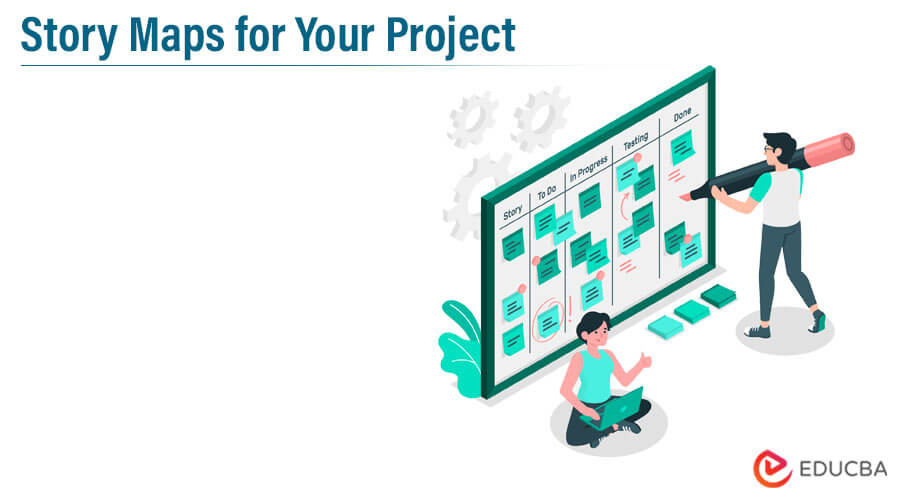Updated June 15, 2023

Introduction to Story Maps for Your Project
Steps to Build Story Maps for your Project – Have you ever entered your department space in your office only to find different colored post-its and note adorning the walls? No, I am not talking about the time your colleagues wished you well on your birthday and painted the walls with colorful post-its, here’s a work-related thing. *wink*
For decades, as Agile project management is slowly taking center-stage when it comes to manufacturing and production, and with Agile’s methodologies slowly seeping into businesses and software development, there’s a great need to know what comes next, what has gone by, and the tasks to be schedules. Agile adopts the use of chunking projects into parts and these parts or user stories will be executed in the order in which you want to build the project
Understanding the Need for Stories
Oftentimes, we spend a lot of time deciphering what the current statuses of our sprints and workflow are, and even with project management tools, we sometimes don’t have an end-to-end view of the activities to be undertaken, especially our user stories. Even if we do have an understanding about these backlog activities, we have no idea where do they all fit in the grand scheme of things; we don’t know just through these activities what it is that we are building? Imagine you get in front of your stakeholders and users and tell them the status of the project. Just by that status, it’s hard to understand more about the product itself as there aren’t any higher-level views involved.
While as a project manager, you’re keeping track of each of these aspects mentioned and are constantly on the run towards getting in pace with the ticking clock. Unfortunately, your team members aren’t on the same pace on foot, nor are your users. While they are indulging in their work and trying their level best to get the current sprint completed, they are facing the issue of committing to it as they don’t know what’s next and where it ends.
The documentation is aplenty and the team members are in abundance. Take a situation where you’re introducing yet another team member to the project. How do you get that person up to speed? Introducing to you—Story Maps!
Let’s Begin with Story Maps
Jeff Patton, the pioneer of Story Maps, explains how he came to understand the value and the problem-solving capabilities that story maps possessed for backlog items and how it could help managers and employees plan out their projects. In his article, The New User Story Backlog is a Map, Patton explicitly talks about the user story map. In a nutshell, he explains that a user story map performs a clear arrangement of the stories that have been occurring over the due course of the project and helps the user understand just how the project functions. He goes on to explain story maps to be the “better version of product backlog”. In the essence, he criticizes the Agile development favorite, the flat backlog, which is essentially story writing, and he states that story maps are elaborated backlogs that help you understand the big picture and never lose track of it.
Taking all these into consideration, I can explain story maps to be the entire view of the product backlog and activities mapped across in a way to tell us the story or the journey that the product is going to take. This useful model of arranging stories helps us understand what the project is going to do for us and if any, helps us identify all the holes and gaps found within the woven story. This story is mostly visually displayed and is easy to be deciphered by the user or third-party personnel.
Building a Story Map
Not many people are aware of the concept of story maps and hence aren’t even sure where to begin with them. Now, since you’re aware of what a story map is, it’s time to dive into creating and building one.
With a little rewinding, you come across story maps as entire elaborated story structures used for better comprehension of a given business problem, encapsulated within a project. Like a script, it acts as a visual enabler of the project and can thus enable project managers and project team members to never shift focus from the main objective of the project and provides an end-to-end view of the entire project.
Just like a film, an entire story map is made up of individual frames or user stories, put together to run like a movie. This movie is your project. To build a sophisticated story map for your project, you will need to undertake the following steps.
Gather the Wood – Requirements Gathering
It’s important that your requirements gathering phase is conducted to the point. Without a clear view of the requirements, the entire plan or vision of the project can turn a little hazy. The entirety of the project lies in what you want to accomplish with the help of the project. A story map can then aid your endeavour to get things up and running and clear as running water.
With a project plan and strategy in place, you must already have a clear idea on the different stages and activities and tasks that should go through a project. This way you will have your big stories and your smaller stories that fit in. These can be used to form the skeletal structure of your project story maps and can get you the entire vision on display.
Arrange the Bonfire – Mapping the Requirements
With all the elements/user stories in place, your next task is to arrange these elements onto a story map, with the big stories taking the top most rows. Arrange the remaining steps below each big story you’ve mapped out.
These big stories are those activities that have multiple steps below them and those that don’t have a particular workflow established for them, not at least without the smaller activities mentioned below them.
Once you’ve arranged the many user stories onto a story map for your project, it’s time that you assign a story to each of them. This story should be a single sentence, encompassing what the activity is all about.
Note: The big stories by themselves might not be deliverables and it’s ok to have them that way.
Break the Logs into Smaller Units – Chunking
This story map is now ready for further breakdown and chunking. Your user stories should go down till the activities cannot be broken down further. Make sure that you make these logical activities solid deliverables and they can yield an output till it escalates to the top user story. You can call these deliverables as user tasks.

Add the Oil – Bringing in Expert Opinion
Bring in your subject matter experts and ask them to evaluate the story map that you’ve arranged. Ask them to check it against the project plan and help them understand the vision of the project. If they get it right, then your story map entails the story precisely as it was expected to be told.
Ask them to evaluate the flow of the stories and activities and tasks so as to make logical sense for you and your project team members.
Set the Fire – Finalizing the Story Map Structure
Once you have a go and appropriate feedback to your story map, it’s time to finalize it and have the charts made and remade to be displayed in the areas where the project will be conducted. It’s important that the previous step is taken carefully into consideration and accordingly, have the story map finalized. Ensure that you have taken a buy-in from all employees, developers, and all stakeholders on the project before you finalize the story map so that everyone is aware of what is happening and where they can run to in case there’s a doubt with the vision of the project.
Poke in the Stick – Testing the Story Map
You now have a fully equipped and assembled story map and you can well enough hang it out on you project team’s vision board for all to see. The next step is to be able to go through the entire story map along with an executive, a developer, a stakeholder, and a user. Talking through the maps with users can help you get to points where you’ve just completely missed a blank space. Understand these points and take down notes as they can be useful the next time you build a story map for your next project.
During this testing phase or walk-through, you will be able to identify the stages in the project or the stories that are going to be hard to overcome and need special attention or stories that are clear opportunities for you to tap on to. At this stage, you will be able to see the value attached to each stage that you have put up there and allocate timelines for each activity and task.
Display the Bonfire – Releasing the Story Map
You have your user stories, you have your tasks and activities, and you have your timeline and value, the only thing left to do it release this story map for your department or concern project team to follow and view. You now have the user stories as your project “backbone” and the rest of the grid as your “skeletal structure”. Each column now has a fully equipped, end-to-end solution for the activities your project has undertaken.
For the purpose of prioritization, it’s efficient work if you keep the top or big stories out of prioritization. Each story there is of umpteen importance and can’t have precedence over each other. To plan your release and prioritize the different stories, activities, and tasks, you will need to look into the skeletal structure. Your backbone remains the way it always is.
Grouping and Prioritizing
A story map isn’t simply a static display of an entire project plan. This is a kind of map that is constantly evolving and shaping and reshaping the way a project evolves. You can update, reprioritize, add, and subtract user stories and activities/tasks at all time. It’s important at all times to group and prioritize these activities so that you know the natural order of the things and make up for any loss of time or schedule.
Demarcate the sprints that you would want to take place and assign them a priority in a row-wise order. This way you’ll be able to gain control over what you have to do and what needs to be done at all times. Try and use different colors post-its or paper parchments for different tasks and user stories and also to mark different stages or modifications. Different colors can also be used for the reasons mentioned below:
- Priority
- Technical- or business-related
- Level of complexity
- Modification to an existing user story
Using different colors will grab the attention of your users, team members, and your stakeholders, and will make them aware of the current situation of the user story. Always ensure that as a project manager, you need to continually update the story map in a way to be up-to-date at all times.
Benefits of Story Mapping
Story maps can be the perfect guides through your project that will not only help you out with making your team members and stakeholders understand what the project is all about but will also enable you to get the most of the project itself. Below listed are a few benefits that you can gain through the implementation of story maps:
- Effective communication tool – Putting everyone on the same page with real-time updates can really boost the way your project steers across to success. As communication is effective so does the feedback from others come across as prompt and in time to save the day.
- Visual aid for the entire project – Having a massive display for your project in the form of user stories can make understanding your project quite easy. Human are more receptive to visual aids than any other form of dictation.
- Roadmap as a guide – A story map will provide you will a great sense of direction once you’ve completed a singular task. It will inform you of what happens next, what have been done, and how much of the current sprint has been completed.
- Helps in prioritizing your sprints and backlog efficiently
- Helps in breaking down big stories in logical smaller elements
Recommended Articles
This is a guide to Story Maps for Your Project. Here we have discussed the basic concept, Building a Story Map along with benefits in detail. You may look at the following articles to learn more –

